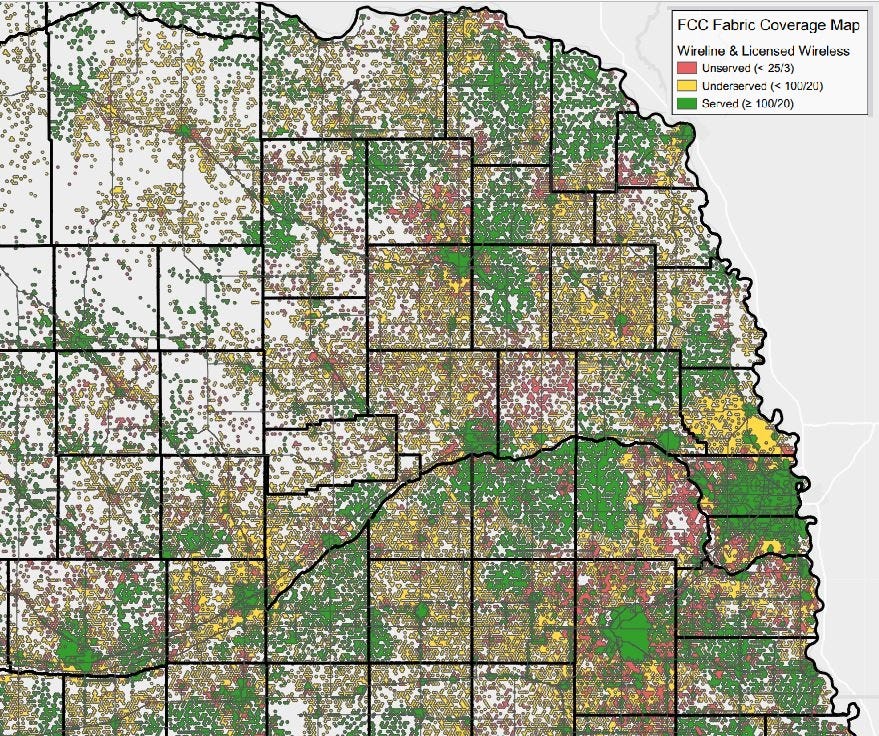Internet, Smartphones, Etc.
Rural America, Broadband
Update, determining who has good internet service can be difficult. https://nebraskaexaminer.com/2023/04/18/sleuthing-discovers-thousands-of-locations-missed-as-unserved-by-broadband-on-federal-map/
When the topic of broadband internet comes up in discussion, few, if any, understand the need. People understand the rural-urban divide but fail to understand how technology and obstacles to it, are at the base of the problem. So let us cover some history.
For tens of thousands of years, transportation was limited in options. Ships were built to transverse rivers, but inventions such as the marine chronometer would allow ships to sail the world. Horses helped in Asia, Europe, and Africa, and made the conquest of the Americas possible. Railroads changed much of land traveling by making wide transportation of goods much easier and faster. Trucks and automobiles would be invented and bring people into closer proximity.
New technologies create new abilities but the newer technologies often encounter new problems. With cars and trucks, roads needed to be built. When electricity became common, the land still provided an obstacle. Rural America was still using light from kerosene. President Franklin Roosevelt saw the need to create the Rural Electrification Administration. Congress would pass the Rural Electrification Act in1936 (https://en.wikipedia.org/wiki/Rural_Electrification_Act) This was supported by Nebraska US Senator George Norris who was still a Republican at the time.
With the birth and spread of the internet and smartphone technology, a wide array of capabilities and information has become available to a vast amount of people. In Omaha, the ease of accessing the internet is as easy as going to the public library or visiting the free tech center, DoSpace (https://dospace.org/). DoSpace even has a group for seniors, Cyber-Seniors which meets weekly (https://dospace.librarycalendar.com/event/cyber-seniors-0) to help people with technology and questions.
Yet rural America is largely cut off from this technology. Elon Musk sees this as an opportunity in creating a satellite-based internet for all. The service is known as Starlink (https://www.starlink.com/) and reaches to the most remote places on Earth. He even has it set to help the use of phone reception. While this helps, it is expensive.
As to Nebraska, you can clearly see on the map below who has access and who does not (See more details with zoom and scrolling functions at: https://broadband.nebraska.gov/BroadbandAvailabilityMap). This map is from the Nebraska Public Service Commission which is in charge of broadband access (https://broadband.nebraska.gov/Home).
For urban people, they simply cannot imagine being in an area where there is no cell phone reception, or where GPS is largely useless because the roads have not been mapped by Google, let alone no Facebook account. The idea of streaming a video in many rural areas is often simply impossible. Zoom meetings can be impossible. The idea of merely downloading a Kindle book can be impossible. This is why broadband technology is so important to developing rural areas and for the sharing of ideas between urban and rural people.
A friend of mine had a home in a rural area. Everyone had put their mobile phones in the corner of a distant room. Why? Because it was the only place in the home where there was cell tower connection. Of course, you can still run into obstacles in urban areas. Have a house where the mobile phone won’t work? Chances are, you have a steel roof which can cut off wireless reception.
Also, there is still the human factor as well. A soldier came home from World War II to his parents' house, a farmhouse in rural America. His parents still used kerosene. He decided to have their home electrified for lights. He came back a year later, to see the house and was stymied as to why the electric lights had not been turned on. His parents were still using only kerosene to light their way. He made efforts to turn on the electric lights for them, but a light bulb burned out. Better to light a kerosene lantern instead of cursing the darkness.



Thanks for Dospace and Cyberseniors. I’ve been involved with for 4 years.
I agree that we need to do more to bring rural areas into the 21st century. One of my uncles ranches in the northwest corner of Nebraska. That part of Nebraska is among the most sparsely populated counties in the state.
Fortunately, his ranch isn't too far from the nearest small town, so he can get internet via wireless. It's a pretty lousy signal, though, and he doesn't use it for anything that he doesn't have to.
TV is far more of an issue: the local Nebraska stations don't provide coverage for that area (no signal). He has to get his weather news from Wyoming via satellite dish--and if the weather is bad (the time when you most would want to know what to expect), he gets no signal at all. Radio signals also aren't great out there when you can get them at all.
Cell phone coverage is also interesting. We totally lose the signal from our cell phone carrier driving into the panhandle. There's a cell phone carrier that operates out that way, but apparently they don't contract to carry signals on their towers for our carrier.
Chadron State Park doesn't get any internet or cell phone service at all. It's smallish for a state park and it's fairly close to Chadron and Scottsbluff, so I really don't understand why they can't manage it. You have to leave the park and drive most of the way into town to get a signal.